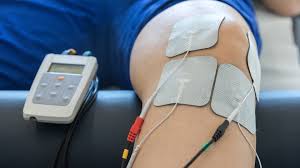Introduction
As a company we commit
ourselves to improve healthcare standards by providing advanced medical
equipment which displays reliable performance. One of our main products called
Interferential Therapy Unit (IFT) represents a recognized solution for pain
treatment and rehabilitation needs. The business unit of Chirag Electronics
develops cutting-edge electrotherapy solutions which combine superior quality
with therapeutic capabilities to benefit patients alongside medical specialists
in patient care.
What Is Interferential Therapy?
Interferential Therapy
(IFT) functions as an electrical stimulation method which medical professionals
mostly apply to manage pain along with inflammation and muscle spasms. Two
medium-frequency currents intersect at a specific body point to generate a
low-frequency beat frequency. The method enables effective tissue stimulation
through its pain-reducing mechanism that advances both healing and pain relief.
How Does Interferential Therapy Work?
IFT functions through the
electrical currents that pass through skin surface to produce a low-frequency
output through mutual current interference. The crossing electrical currents
produce a slow-frequency beat current when they interfere with each other at
the point where they meet. Deep tissue penetration activates muscles and nerves
to raise blood circulation and enable natural healing functions. Interferential Therapy treatment
works effectively for treating pain conditions of different durations and soft
tissue injuries as well as joint pain and muscle therapeutic needs.
Key Benefits of Interferential Therapy
1. Effective
Pain Relief: Interferential therapy serves as a standard treatment because it
successfully helps patients recover from acute and continuous pain damages.
Patients achieve excellent results with this treatment method when facing
conditions which include lower back pain together with sciatica along with
joint pain.
1. Improved
Blood Circulation:: Through its mechanism the treatment increases blood
circulation in specific body areas which speeds up healing responses and
tissues restore themselves.
2. Muscle
Relaxation: Interferential treatment enables muscle relaxation while
simultaneously reducing muscle spasms and stiffness in order to support quicker
recovery of the muscles.
3. Non-Invasive:
Interferential therapy maintains popularity because it avoids hospital
procedures and drugs thus becoming the approach of choice for pain management
among patients.
4. Safe
and Comfortable: The treatment is considered secure for most patients while
displaying only light undesired effects and showing good tolerance across
various patients. Furthermore the procedure causes completely painless
sensations while some patients notice a minimal tingling feeling during the
therapy.
Features of Chirag Electronics’ Interferential
Therapy Unit
• Adjustable Intensity: Each
setting on the IFT unit can be modified according to individual need levels for
pain and therapeutic requirements.
• Pre-set Programs: The
device presents a range of pre-established programs that healthcare providers
find easy to operate for various types of pain therapy.
• User-Friendly
Interface: A user-friendly interface on this device includes simple displays
which enable practitioners and patients to operate it without difficulty.
• Portable Design: The
portable format of this unit enables its use in medical institutions together
with home-based therapy settings for ongoing treatments.
• Safety Features: The
unit incorporates multiple safety features together with over-current
protection and timer functions which allow secure treatment of patients.
Applications of Interferential Therapy
• Musculoskeletal Pain: Medical
practitioners use IFT as a standard procedure for treating pains that originate
from muscular injuries and ligament damage as well as joint disturbances.
• Sports Injuries: The
utilisation of Interferential Therapy by athletes helps their injuries heal
faster because of its positive effects on sprains and strains and soft tissue
injuries.
• Chronic Pain
Management: The treatment proves highly effective when managing persistent pain
affected individuals who have osteoarthritis fibromyalgia or lower back pain.
• Post-Surgical
Rehabilitation: The application of Interferential therapy within post-surgical
rehabilitation specifically helps patients to attain quicker healing while
minimizing their pain.
• Muscle Recovery: Physiotherapists
utilize the treatment to relax muscles after strenuous physical exertion or
muscle exhaustion.
Why Choose Chirag Electronics’ Interferential Therapy Unit?
Since its inception Chirag Electronics has built its name around delivering
trustworthy medical equipment of top quality standards. The therapeutic
capacities of our Interferential Therapy Unit reach their peak potential
through precise design dimensions. Other IFT unit features entice our customers
because of these following elements:
The reliability of our products comes from comprehensive
testing that verifies our products reach top safety and operational standards.
We operate a dedicated team that provides both
client service and technical assistance which supports your setup and usage as
well as maintenance requirements.
We aim to give customers access to high-quality
medical equipment through competitive pricing frameworks that enhances advanced
therapeutic options for more people.
Our IFT unit showcases exceptional durability
because it incorporates reliable robust materials meant for extended prolonged
application.
Conclusion
Chirag Electronics remains dedicated to developing new solutions which advance
patient well-being as well as healthcare professional treatment practices. The
Interferential Therapy Unit stands as a superior device for both rehabilitation
purposes and pain management because it assists patients with multiple medical
conditions. The IFT unit from our company serves both professionals and
patients through its secure pain management approach that achieves results at
lower expense.
Purchasing from Chirag Electronics involves
investing in advanced medical technology that combines institutional experience
with customer satisfaction guarantees.

.jpg)

.jpg)


